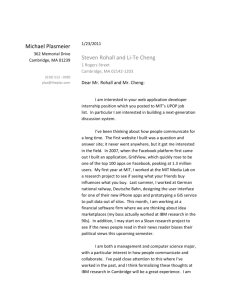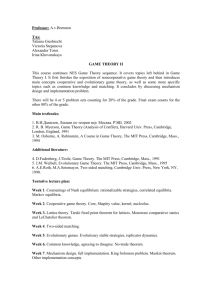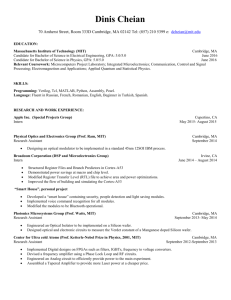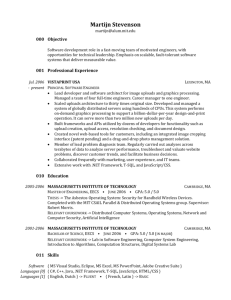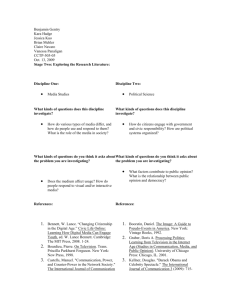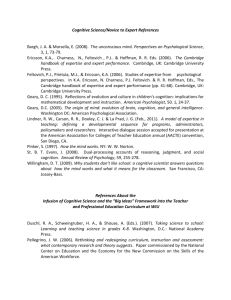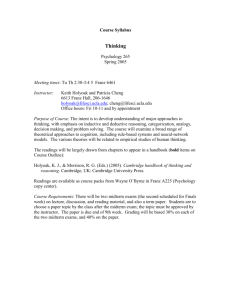mit eds
advertisement
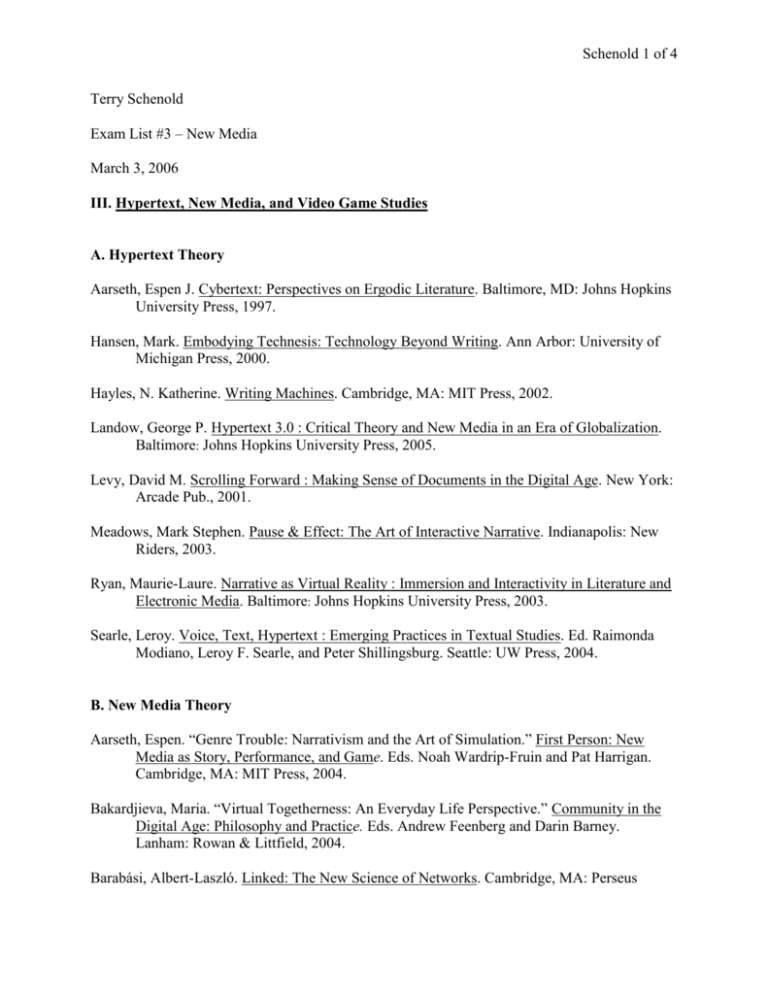
Schenold 1 of 4 Terry Schenold Exam List #3 – New Media March 3, 2006 III. Hypertext, New Media, and Video Game Studies A. Hypertext Theory Aarseth, Espen J. Cybertext: Perspectives on Ergodic Literature. Baltimore, MD: Johns Hopkins University Press, 1997. Hansen, Mark. Embodying Technesis: Technology Beyond Writing. Ann Arbor: University of Michigan Press, 2000. Hayles, N. Katherine. Writing Machines. Cambridge, MA: MIT Press, 2002. Landow, George P. Hypertext 3.0 : Critical Theory and New Media in an Era of Globalization. Baltimore: Johns Hopkins University Press, 2005. Levy, David M. Scrolling Forward : Making Sense of Documents in the Digital Age. New York: Arcade Pub., 2001. Meadows, Mark Stephen. Pause & Effect: The Art of Interactive Narrative. Indianapolis: New Riders, 2003. Ryan, Maurie-Laure. Narrative as Virtual Reality : Immersion and Interactivity in Literature and Electronic Media. Baltimore: Johns Hopkins University Press, 2003. Searle, Leroy. Voice, Text, Hypertext : Emerging Practices in Textual Studies. Ed. Raimonda Modiano, Leroy F. Searle, and Peter Shillingsburg. Seattle: UW Press, 2004. B. New Media Theory Aarseth, Espen. “Genre Trouble: Narrativism and the Art of Simulation.” First Person: New Media as Story, Performance, and Game. Eds. Noah Wardrip-Fruin and Pat Harrigan. Cambridge, MA: MIT Press, 2004. Bakardjieva, Maria. “Virtual Togetherness: An Everyday Life Perspective.” Community in the Digital Age: Philosophy and Practice. Eds. Andrew Feenberg and Darin Barney. Lanham: Rowan & Littfield, 2004. Barabási, Albert-Laszló. Linked: The New Science of Networks. Cambridge, MA: Perseus Schenold 2 of 4 Publishers, 2002. Bolter, Jay David and Grusin, Richard. Remediation: Understanding New Media. Cambridge: MIT Press, 2000. ___ and Diane Gromala. Windows and Mirrors : Interaction design, Digital art, and the Myth of Transparency. Cambridge, MA: MIT Press, 2003. Manovich, Lev. The Language of New Media. Cambridge, MA: MIT Press, 2001. Hansen, Mark. New Philosophy for New Media.Cambridge, MA: MIT, 2004. Hayles, N. Katherine. My Mother Was a Computer : Digital Subjects and Literary Texts. Chicago: University of Chicago Press, 2005. Tabbi, Joseph. Reading Matters: Narrative in the New Media Ecology. Eds. Joseph Tabbi & Michael Wutz. Ithaca, NY: Cornell University Press, 1997. Thurtle, Phillip. Data Made Flesh : Embodying Information. Eds. Robert Mitchell and Phillip Thurtle. New York : Routledge, 2004 Poster, Mark. Information Subject. New York: Routledge, 2001. Rodowick, D. N. Reading the Figural or Philosophy After the New Media. Durham, NC: Duke University Press, 2001. Taylor, Mark C. The Moment of Complexity: Emerging Network Culture. Chicago: The University of Chicago Press, 2001. C. Cyberspace and Video Game Studies Alexander, Thor. Massively Multiplayer Game Development. Charles River Media, 2003. ___. Massively Multiplayer Game Development 2. Charles River Media, 2005. Bartle, Richard. Designing Virtual Worlds. New Riders Games, 2003. Benedikt, Michael. “Cyberspace: Some Proposals.” Cyberspace: First Steps. Ed. Michael Benedikt. Cambridge, MA: MIT, 1991. Borgmann, Albert. “Is the Internet the Solution to the Problem of Community.” Community in the Digital Age: Philosophy and Practice. Eds. Andrew Feenberg and Darin Barney. Lanham: Rowan & Littfield, 2004. Bromage, Adrian. "Atatvistic [Atavistic] Avatars: Ontology, Education and 'Virtual Worlds'." Schenold 3 of 4 Virtual Learning and Higher Education. Ed. David Seth Preston. Amsterdam, Netherlands: Rodopi, 2004. Dreyfus, Hubert. “Nihilism on the Information Highway.” Community in the Digital Age: Philosophy and Practice. Eds. Andrew Feenberg and Darin Barney. Lanham: Rowan & Littfield, 2004. Filiciak, Miroslaw. “Hyperidentities: Postmodern.Identity Patterns in Massively Multiplayer Online Role-Playing Games.” The Video Game Theory Reader. Ed. Mark J.P. Wolf and Bernard Perron. New York: Routledge, 2003. Friedl, Markus. Online Game Interactivity Theory. Charles River Media, 2002. Garrelts, Nate. Digital Gameplay: Essays on the Nexus of Game and Gamer. Jefferson, NC: McFarland & Company, 2005. Hayot, Erid and Edward Wesp. “Reading Game/Text: EverQuest, Alienation, and Digital Communities.” Postmodern Culture.14.2, 2004. Heim, Michael. “The Erotic Ontology of Cyberspace” Cyberspace: First Steps. Ed. Michael Benedikt. Cambridge, MA: MIT, 1991. Jenkins, Henry. “Game Design as Narrative Architecture.” First Person: New Media as Story, Performance, and Game. Eds. Noah Wardrip-Fruin and Pat Harrigan. Cambridge, MA: MIT Press, 2004. Juul, Jesper. Half-Real : Video Games between Real Rules and Fictional Worlds. Cambridge, MA: MIT Press, 2005. ___. “Introduction to Game Time.” First Person: New Media as Story, Performance, and Game. Eds. Noah Wardrip-Fruin and Pat Harrigan. Cambridge, MA: MIT Press, 2004. Mäyrä, Frans. “The Quiet Revolution: Three Theses for the Future of Game Studies” DiGRA.org. < http://www.digra.org/article.php?story=20050327082956955 > McMahan, Alison. “Immersion, Engagement, and Presence.” The Video Game Theory Reader. Ed. Mark J.P. Wolf and Bernard Perron. New York: Routledge, 2003. Moulthrop, Stuart. “From Work to Play: Molecular Culture in the Time of Deadly Games.” First Person: New Media as Story, Performance, and Game. Eds. Noah Wardrip-Fruin and Pat Harrigan. Cambridge, MA: MIT Press, 2004. Murray, Janet. “From Game-Story to Cyberdrama.” First Person: New Media as Story, Performance, and Game. Eds. Noah Wardrip-Fruin and Pat Harrigan. Cambridge, MA: MIT Press, 2004. Schenold 4 of 4 Newman, James. “The Myth of the Ergodic Videogame.” Game Studies.org. 2:1 (2002) < http://www.gamestudies.org/0102/newman/ > Novak, Marcos. “Liquid Architectures in Cyberspace.” Cyberspace: First Steps. Ed. Michael Benedikt. Cambridge, MA: MIT, 1991. Pearce, Celia. “Towards a Game Theory of Game.” First Person: New Media as Story, Performance, and Game. Eds. Noah Wardrip-Fruin and Pat Harrigan. Cambridge, MA: MIT Press, 2004. Penny, Simon. “Representation, Enaction, and the Ethics of Simulation.” First Person: New Media as Story, Performance, and Game. Eds. Noah Wardrip-Fruin and Pat Harrigan. Cambridge, MA: MIT Press, 2004. Perlin, Ken. “Can There Be a Form Between a Game and a Story?” First Person: New Media as Story, Performance, and Game. Eds. Noah Wardrip-Fruin and Pat Harrigan. Cambridge, MA: MIT Press, 2004. Poole, Steven. Trigger Happy: Videogames and the Entertainment Revolution. New York: Arcade, 2000. Rehak, Bob. “Playing at Being: Psychonalaysis and the Avatar.” The Video Game Theory Reader. Ed. Mark J.P. Wolf and Bernard Perron. New York: Routledge, 2003. Rooksby, Emma. "Empathy in Computer-Mediated Communication." Virtual Morality. Ed. Mark J.P. Wolf. .New York: Peter Lang, 2003. Spector, Warren. “Module 2: Games as Simulacra.” Re:play: Game Design +Game Culture. Eds. Amy Scholder and Eric Zimmerman. New York: Peter Lang, 2003. Stone, Allucquere. “Will the Real Body Please Stand Up?” Cyberspace: First Steps. Ed. Michael Benedikt. Cambridge, MA: MIT, 1991. Wolf, Mark. The Medium of the Video Game. Austin: University of Texas Press, 2002. ___. "From Simulation to Emulation: Ethics, Worldviews, and Video Games." Virtual Morality. Ed. Mark J.P. Wolf. New York: Peter Lang, 2003. ___. “Abstraction in the Video Game.” The Video Game Theory Reader. Ed. Mark J.P. Wolf and Bernard Perron. New York: Routledge, 2003. Zimmerman, Eric. The Game Design Reader : A Rules of Play Anthology. Eds. Katie Salen and Eric Zimmerman. Camrbidge, MA: MIT Press, 2005.
